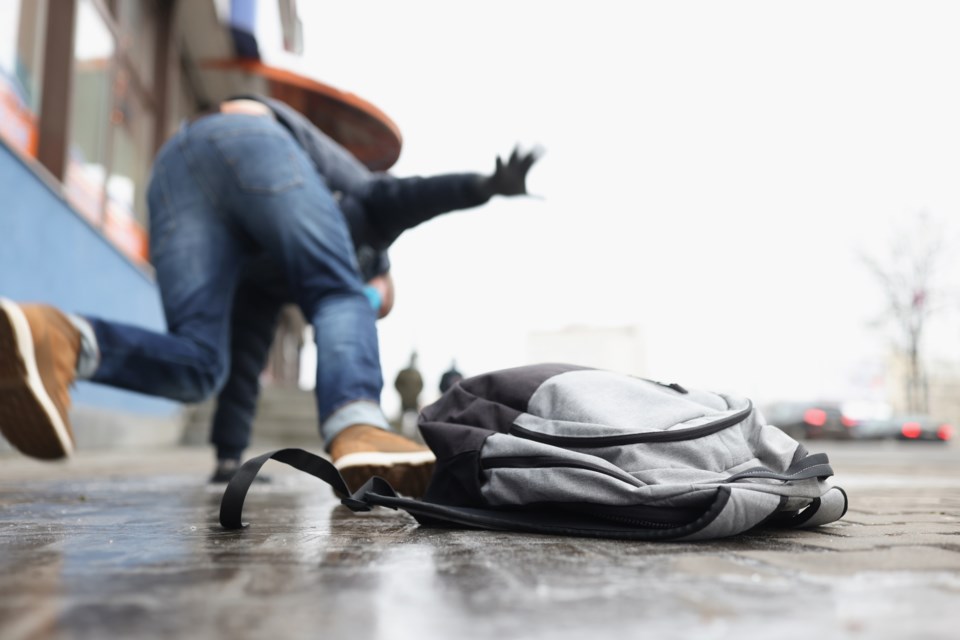With temperatures beginning to drop in Northwestern Ontario, it can only mean one thing — the beginning of ice and snow season, hazardous walking conditions, and falls.
“Whether it occurs on an icy parking lot, a wet floor of a grocery store, or a staircase that is non-compliant with the Building Code, falls can lead to serious injuries including broken bones, brain injuries, or even death,” says Jeff Moorley, a personal injury lawyer and partner at White Macgillivray Lester LLP, located in Thunder Bay’s Waterfront District.
Occupiers’ liability is a legal concept that outlines the rights and responsibilities of those who control, possess, and use property. In this article, we delve into the fundamentals of occupiers’ liability and tips to keep in mind in case you or a loved one suffers a serious fall.
Be aware of the standard of care
When you step onto someone else’s property, whether a retail store, a friend’s house, or a public park, you expect a reasonable level of safety.
Under Ontario law, an occupier must take reasonable care to ensure that individuals on the premises are reasonably safe. This is commonly called the standard of care.
“An occupier is not liable for losses simply because a fall happened,” says Moorley. “It must be proven on balance of probabilities that the occupier acted unreasonably and that this unreasonable conduct caused the fall.”
Unreasonable conduct typically involves a failure to maintain the premises adequately. Examples include allowing patches of ice to build up in high-traffic areas, failing to salt or sand icy areas, or failing to fix trip edges.
The term ‘occupier’ is much broader than just the owner of a property. It includes any person, business, or organization that has control over the premises. There can be more than one occupier at any given time. Maintenance contractors are often occupiers.
Collect evidence
“The success or failure of a fall claim often turns on the quality of the liability evidence,” says Moorley.
“In every occupiers’ liability claim the hazard that allegedly caused the injury is scrutinized.” He explains, “if you are injured in a fall, you would be wise to take photographs of the hazard and the surrounding area. Leave no doubt as to the location and characteristics of the hazard. Timely photographs are essential in cases involving slip and falls on ice, as the hazard often changes day-to-day with the weather.”

“In falls involving a trip edge, consider photographing measurements of the hazard. Once reported, trip edges are often patched, ground down, or otherwise repaired, destroying evidence of the hazard in the process.”
Moorley adds that it is also important to take photos of your footwear to prove that they were in good condition at the time of the fall, as insurance companies often allege that claimant fell because their footwear was not reasonable for the circumstances.
Give prompt notice of a claim
It is best to provide written notice of a potential claim as soon as possible after an injury.
The notice informs the occupier and their insurance company of a potential claim. The insurer can then investigate the claim to determine how the fall happened and the extent of the claimant’s losses.
“When an injury is caused by snow or ice, timely written notice of the incident is not just a good idea -- it is the law. Occupiers of the premises must receive notice within 60 days of the fall, or else the claim may be legally barred, subject to some narrow exceptions,” says Moorley.
Be aware of special rules for claims involving the government
Claims against the government are complex, as special rules or exceptions often apply.
For example, in Ontario, for falls on municipal roads or sidewalks written notice of the incident must be provided to the clerk of the municipality within a mere 10 days of the incident. The notice must include the location of the incident and a description of the injury suffered. Failure to meet this tight deadline will not bar a claim if a ‘reasonable excuse’ can be proven and the delay does not prejudice the municipality.
Different standards may also be against the government. For example, when snow or ice causes a fall on a public road or sidewalk, municipalities will only be responsible if their conduct was ‘grossly negligent’. This is a significantly lower benchmark than the normal ‘reasonable’ standard of care.
Consult an experienced personal injury lawyer
Occupiers’ liability is a vital legal concept that balances the rights of property owners with the safety of visitors.
If you are injured on someone else’s property, you should consult with an experienced personal injury lawyer to assess your situation and explore the viability of a claim.
A good personal injury lawyer will not only be knowledgeable about how insurance coverage works and how to clearly explain your legal options; they will also know the communities they serve and the resources available in the area.
“Our firm knows Northwestern Ontario – how accidents happen here, the hospitals, doctors, clinics, and care providers,” says Moorley. “We can investigate the site of the incident immediately. This is a significant advantage of hiring local versus retaining a lawyer from say, Southern Ontario. With this knowledge and experience, we can hit the ground running for our clients.”
For more information or to schedule a free consultation, contact White Macgillivray Lester LLP, the Agents of Good, at (807) 344-1000 or https://tbayinjurylaw.com/contact/. Follow them on Facebook for legal information and tips.



